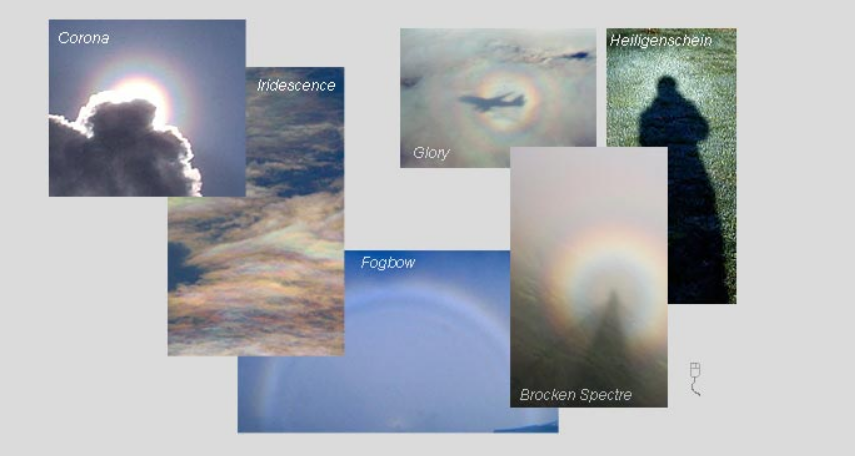Droplets: Corona, Iridescent Clouds
Droplets: Corona, Iridescent Clouds
When it comes to atmospheric optics, the mesmerizing effects created by tiny water droplets in clouds, mists, and fogs are truly captivating. These droplets give rise to a range of optical phenomena, often characterized by ringed patterns and vibrant colors. In this article, we will delve into the fascinating world of droplet-induced optical effects, exploring the intricate interplay of wave diffraction, interference, and light propagation.
In this domain of minuscule water droplets, the concept of "rays" loses its traditional meaning. The size of the droplets is so small that the classical notion of light following a straight-line path is overshadowed by wave phenomena. Diffraction and interference become the dominant factors shaping the behavior of light as it interacts with these tiny droplets.
Let's take a closer look at two intriguing optical effects associated with droplets: the corona and iridescent clouds.
The Corona Effect
The corona effect is a remarkable phenomenon that occurs when light encounters tiny water droplets suspended in the air. When sunlight or moonlight passes through these droplets, it undergoes diffraction and interference, leading to the formation of a circular pattern of colored rings around the light source. The corona effect is often observed around the Sun or the Moon, where the droplets act as miniature prisms, dispersing the light into its constituent colors.
How Does the Corona Effect Occur?
The corona effect arises from the diffraction and interference of light waves as they pass through the droplets. As sunlight or moonlight enters a droplet, it refracts and internally reflects within the droplet before exiting. This internal reflection leads to constructive and destructive interference of the diffracted waves, resulting in the formation of concentric rings of varying colors around the light source.
The Colors of the Corona
The colors observed in a corona are a direct consequence of the constructive and destructive interference of light waves. The droplets act as tiny prisms, dispersing the incident light into its constituent colors. The size of the droplets determines the color sequence observed, with larger droplets producing more distinct and vibrant rings. The innermost ring is typically blue, followed by a series of pale greens, yellows, oranges, and reds.
Iridescent Clouds
Iridescent clouds are another captivating optical phenomenon that arises from the interaction of light with water droplets in the atmosphere. These clouds exhibit vibrant, shimmering colors, often resembling a kaleidoscope. The iridescence is caused by the diffraction and interference of sunlight as it interacts with the tiny droplets present in the cloud.
How Do Iridescent Clouds Form?
Iridescent clouds form when sunlight passes through thin, high-altitude clouds composed of tiny water droplets or ice crystals. As the light encounters these microscopic particles, it undergoes diffraction and interference, resulting in the scattering of specific wavelengths. This scattering leads to the formation of a stunning display of colors within the cloud, with hues ranging from blues and greens to pinks and purples.
Factors Influencing Iridescence
Several factors influence the intensity and extent of iridescence observed in clouds. The size and shape of the water droplets or ice crystals play a crucial role. Smaller droplets tend to produce more vibrant colors, while larger droplets may lead to a broader range of hues. Additionally, the angle at which sunlight interacts with the cloud, as well as the overall thickness and density of the cloud layer, can impact the appearance of iridescence.
Conclusion
The intricate world of atmospheric optics never ceases to amaze us. From the corona effect to iridescent clouds, the interplay between light and tiny water droplets creates breathtaking displays of color and patterns in the sky. Understanding the principles behind these optical phenomena allows us to appreciate the beauty and complexity of our natural environment. So, next time you find yourself gazing at the sky, take a moment to marvel at the wonders of droplets and their ability to transform ordinary light into extraordinary spectacles.

The tiny water droplets of clouds mists and fogs produce strange optical effects, they are mostly ringed and mostly brightly coloured.
"Rays" have little meaning in this domain where water droplets are so small that wave diffraction and interference dominate over classical journeys of light along straight lines.
Note: this article has been automatically converted from the old site and may not appear as intended. You can find the original article here.
Reference Atmospheric Optics
If you use any of the definitions, information, or data presented on Atmospheric Optics, please copy the link or reference below to properly credit us as the reference source. Thank you!
-
<a href="https://atoptics.co.uk/blog/droplets-corona-iridescent-clouds/">Droplets: Corona, Iridescent Clouds</a>
-
"Droplets: Corona, Iridescent Clouds". Atmospheric Optics. Accessed on April 27, 2024. https://atoptics.co.uk/blog/droplets-corona-iridescent-clouds/.
-
"Droplets: Corona, Iridescent Clouds". Atmospheric Optics, https://atoptics.co.uk/blog/droplets-corona-iridescent-clouds/. Accessed 27 April, 2024
-
Droplets: Corona, Iridescent Clouds. Atmospheric Optics. Retrieved from https://atoptics.co.uk/blog/droplets-corona-iridescent-clouds/.